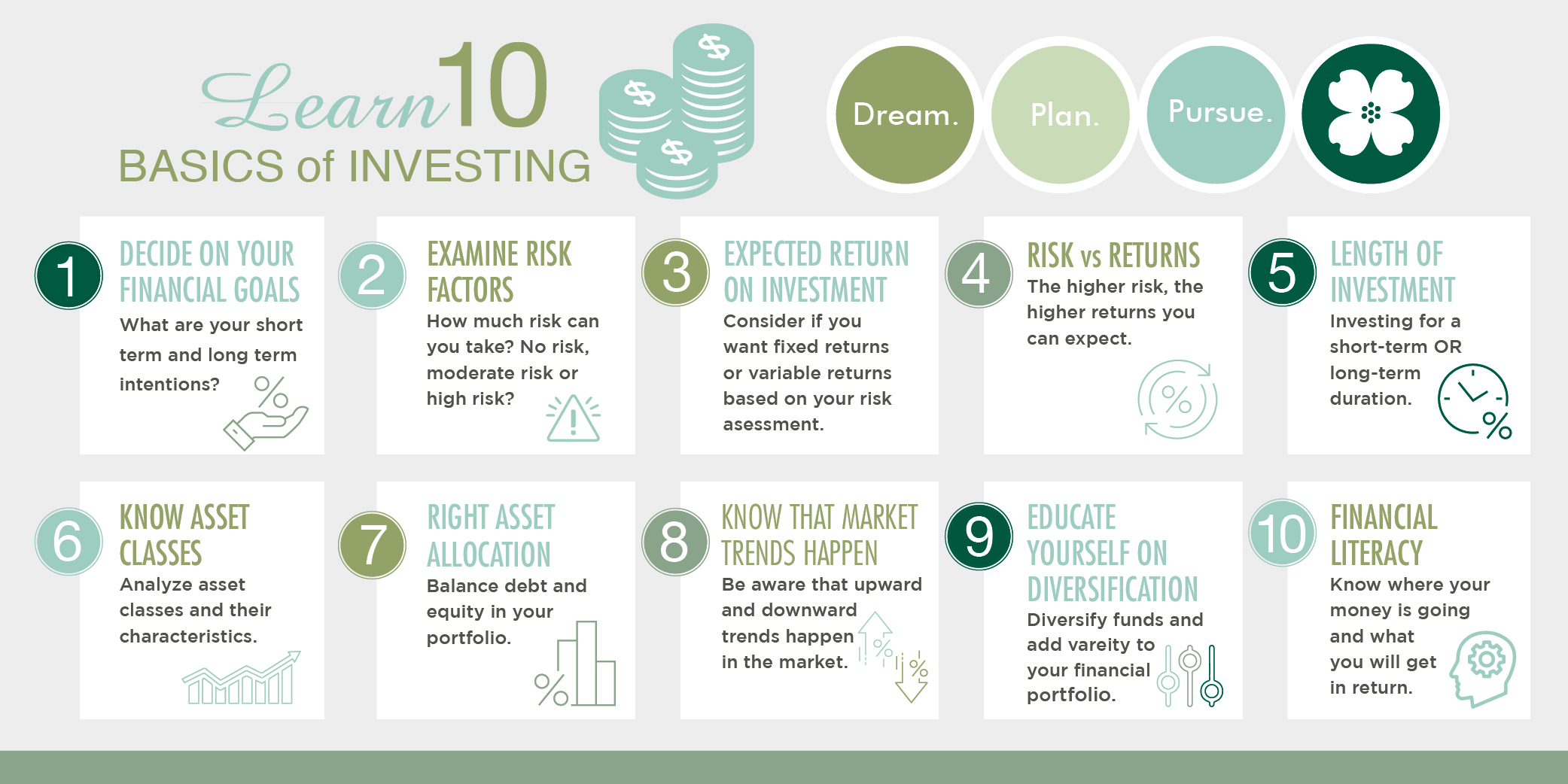
Different stages of life mean different strategies for your portfolio – what is important about investing while in your 20’s?
Different stages of life mean different strategies for your portfolio – what’s important about investing while in your 20’s?
While in your 20’s, time is on your side with your investments. Right now, compound interest is key in making your money work for you. Compound interest is interest calculated on your original investment amount, and includes all of the accumulated interest from previous periods. Then the cycle continues: as you earn money on interest, it can fold into your principal amount, increasing your investment, therefore increasing the interest you earn.
You’ll see your account balance grow more quickly with the accounts that pay interest more frequently. Check out our Compounding Interest Calculator to see the benefits of compounding.
Along with compounding interest, here’s a few ways to make the most of investing while in your 20’s.
Set Goals
Before doing any sort of investing, map out what you’d like to achieve in the short and long-term. This will help keep you on track, and give an opportunity to understand what you want to do with the wealth you earn. When evaluating your short and long-term goals, consider if your budget is helping work toward those goals. Don’t have a budget? Now is a good time to create one! Many different budgeting strategies exist, making it easier to find one that fits your lifestyle. Consider what your highest priority is, and how you will achieve it.
- Your short-term goals are things you aim to accomplish in the near future, typically within the next 12 months or less. Savings for short-term goals are generally better kept in an interest-bearing savings account, rather than the stock market. The stock market can be more of a longer-term strategy, since investments can fluctuate with the market, and may need more time to recover.
- Your long-term goals are usually what you want to accomplish in the next five or more years. Savings for long-term can include a mix of stocks and bonds, giving your portfolio exposure to higher-risk assets, which can yield a more profitable return.
Stay focused and regularly contribute toward your goal, while managing any other expenses. It’s also important to routinely evaluate your goals, and make sure they align with your current and future needs.
Maximize your Employer-Sponsored Retirement Plan
While retirement may seem far away, take advantage of the fact you have time on your side to save as much as possible. Many retirement accounts exist that offer tax-free compounding interest, income, and returns. The best, and oftentimes easiest, place to start is with your employer. If your employer offers a retirement plan match, be sure you’re contributing enough to meet the match requirement. It’s basically free money! When you invest enough in your employer’s plan to receive the match, consider maximizing contributions to other tax-advantage accounts. A few good options include a Roth IRA or deductible traditional IRA, your employer retirement plan, traditional nondeductible IRA, and a taxable account. Also, consider utilizing a Health Savings Account (HSA) to help increase your retirement savings.
Make Saving Automatic
Anytime you receive money, get in the habit of “paying yourself first.” The idea is to treat your savings account like a bill you need to pay. Most banks will allow you to set up a recurring or automatic transfer from your checking account into your savings account. Anytime you get a paycheck, you won’t have to remember to put money in your savings – it’s done for you!
Many technology tools exist to help you “micro save,” like allowing you to “round up” your transactions to the nearest whole dollar and put the extra change directly into your savings, or set a certain dollar amount to go directly into your savings with each transaction.
Along with automating your savings, consider “Dollar-Cost Averaging (DCA).” DCA is an investment strategy in which an investor divides the total amount to invest across periodic purchases of a target asset, trying to reduce the impact of volatility on the overall purchase.¹ Basically, to reduce the impact of volatility on the purchase of an asset, an investor will divide the amount invested across periodic purchases . These regular, periodic purchases happen regardless of the asset’s price. In turn, this strategy removes a lot of the detailed work of trying to time the market in order to purchase assets at the best price.
The DCA method is a way to build savings and wealth over a longer period of time. It’s also a way to neutralize short-term volatility in the broader equity market. You can potentially lower your average purchase price by buying equal dollar amounts over time because you can buy fewer shares when prices are high, and more shares when prices are low. A good example of this is a 401(k) plan, which makes regular purchases regardless of the price of any given equity within the account.
Have an Emergency Fund or Rainy Day Fund
It’s important to have savings outside of your investments, and to financially prepare for unexpected emergencies. Going a little deeper, consider putting a portion of your regular savings into an “emergency fund.” Contributing to your emergency fund should take priority over extra debt repayment or additional investing. Even putting away a small amount of money will add up over time. Your emergency fund should contain at least three to 12 months’ worth of expenses.
Starting out, a good contribution is putting 10% of your regular savings into your emergency fund. It might be helpful to put your emergency fund into a separate savings account, so you can keep a closer eye on its growth, and to help differentiate from your regular savings account.
Make Risk Your Friend
You’ve likely heard the phrase “high risk equals high reward,” and it’s especially relevant when your assets have more time to recover. By having time on your side, you can make more risky investing decisions. As is the case with any asset, you might see a drop in the market in the short-term, which is why short-term investing in stocks likely won’t produce your desired return. Since you’re starting while in your 20’s, you have a longer investing horizon which means you can handle more risk.

Consider Working with a Financial Advisor
A financial advisor can help navigate through the uncertainty, and will evaluate your short and long-term goals to make sure you’re on track. Consider what you want to accomplish for your retirement, factoring in saving and investing options, inflation, Social Security benefits, your longevity and health care expenses. While a lot of information exists for you to do research, it’s beneficial to consult with a professional who can guide you through the steps of creating a personalized financial plan.
Sources:
¹Dollar-Cost Averaging (DCA ) , Investopedia
5 Investing Tips for Your 20s, Nerd Wallet
Investing in your 20s, Edward Jones
Investing By Age Series: Investing In Your 20s, Forbes
This material is intended for informational purposes only, and should only be relied upon when coordinated with specific individualized professional advice, as individual situations will vary.
Contributions to a traditional IRA may be tax deductible in the contribution year, with current income tax sue at withdrawal. Withdrawals prior to age 59 ½ may result in a 10% IRS penalty tax in addition to current income tax.
A Roth IRA offers tax deferral on any earnings in the account. Qualified withdrawals of earnings form the account are tax-free. Withdrawals of earnings prior to the account being opened for 5 years, whichever is later, may result in a 10% IRS penalty tax. Limitations and restrictions may apply.
Dollar cost averaging involves continuous investment in securities regardless of fluctuation in price levels of such securities. An investor should consider their ability to continue purchasing through fluctuating price levels. Such a plan does not assure a profit and does not protect against loss in declining markets.
Category: Investing
